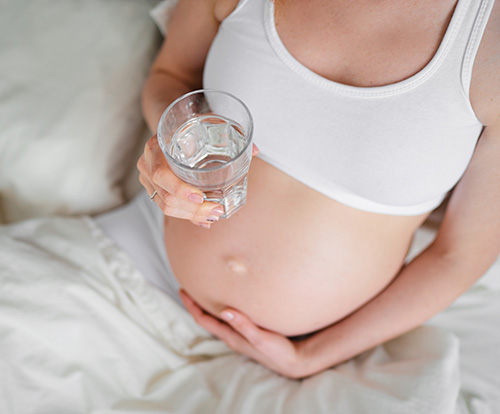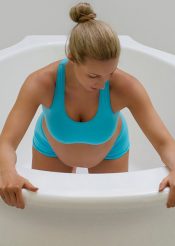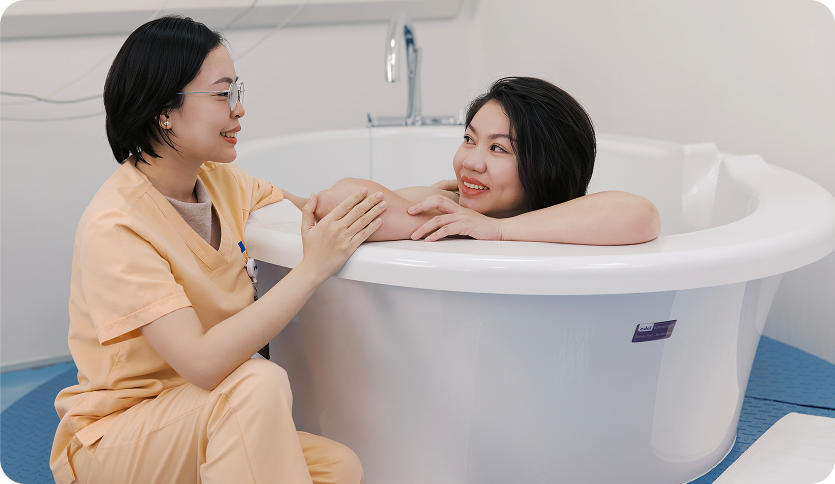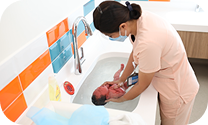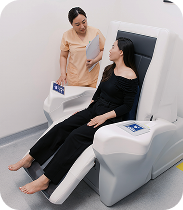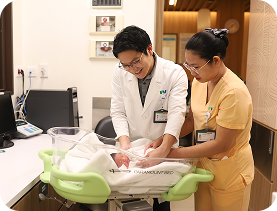The use of water for labour and birth can be traced back to ancient times. Water labour is the process of labouring in a birthing pool filled with warm water. The water can help with pain relief, and some women find it relaxing and soothing. The theory is that since the baby has been in amniotic fluid for nine months, giving birth in water is gentler for the baby.
The delivery suite at FV Hospital offers a comfortable birthing pool. Healthy women with straightforward pregnancies over 37 weeks are offered the possibility of using it for labour if they wish to do so.
If you are considering water labour, please discuss with your obstetrician and midwife.
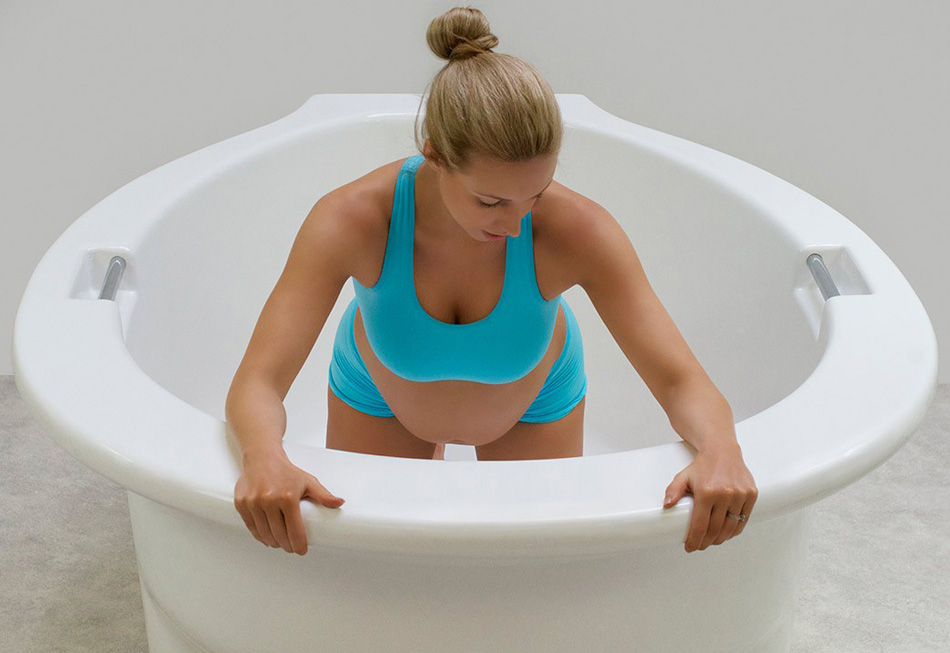
WHAT ARE THE BENEFITS OF WATER LABOUR?
- Experience less contraction pain and less backache. Pain in labour is felt when the muscles in your uterus (womb) contract and your perineum (the skin and muscles between your vagina and rectum, also called your back passage) stretches in preparation for birth. Warm water has a soothing effect, relaxing your muscles and encouraging the release of endorphins. Endorphins are your body’s natural pain-relieving hormones.
- Use significantly fewer pharmacological forms of pain relief such as pethidine or epidural.
- Feel less anxious and more relaxed. As well as relieving pain, endorphins increase your sense of wellbeing. Woman who used water for labour and birth frequently describe it as relaxing and calming.
- Move around and change position more easily. This is due to the buoyancy effect created by the depth of the water. The water in a birthing pool will support 75% of your This allows you to move around the pool more easily. This support saves you energy, which gives you more energy for labour itself. It also makes it easier for you to change your position and adopt an upright position.
- Remain upright. Being upright in labour encourages more efficient contractions and allows gravity to assist you. This encourages your baby to descend through your birth canal in the best position.
- Feel empowered, involved in decision-making and in control. This is partly due to your increased mobility but also due to the sense of privacy created by the water.
WHAT ARE THE RISKS OF LABOURING IN WATER?
There is no increased risk to you or your baby if you labour and even birth in water compared to ‘dry’ land. The option to labour in water does not have a higher risk of infection than labouring without water. For healthy women with an uncomplicated term pregnancy, complications appear quite rare provided guidelines for the use of water in labour are followed carefully. Your midwifery team will follow specific guidelines to ensure the pool you use is clean. If you have an infection, such as herpes, or you are feeling feverish and unwell, your midwife will advise you not to use the pool.
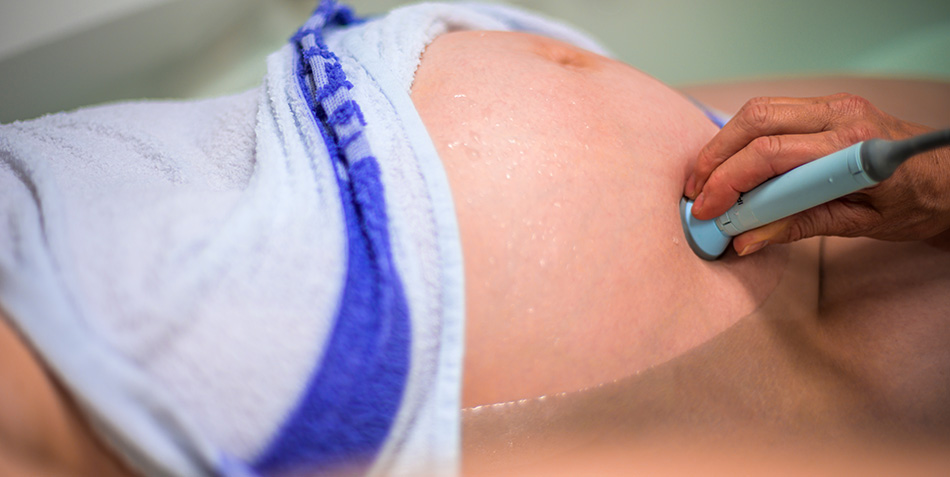
LENGTH OF LABOUR
Based on the research that has been done on this topic so far, it’s not clear whether water itself affects the length of your labour. What we do know is that stress and anxiety have been associated with weaker and less frequent contractions and therefore a slower labour. Labouring in water provides pain relief, which encourages women who are feeling stressed and anxious to relax. This allows labour to progress at its usual rate.
Despite this, it is important to avoid getting into the pool too early, however tempting this may be, as it can sometimes slow down your labour. Ideally, you should wait until your labour is established. Please speak to your doctor or midwife if you feel you need more pain relief.
IS LABOURING IN WATER APPROPRIATE FOR YOU?
You should be able to use the pool if you have had an uncomplicated pregnancy and are between 37 and 42 weeks pregnant and haven’t suffered from any serious medical conditions or complications during this or any previous pregnancy. Unfortunately, it is only possible to use the pool if you are pregnant with one baby, and your baby is lying with its head down (cephalic presentation). You should also be physically able to get in and out of the pool, and have a Body Mass Index (BMI) of 35 or less.
WHO CANNOT USE THE POOL?
- Your waters are brown, green or blood-stained;
- There is more than 24 hours between your waters breaking and established labour beginning;
- Continuous monitoring of your baby’s heartbeat has been recommended;
- You have a known or suspected infection
- You are expecting twins
- You have a medical condition e.g. preeclampsia, epilepsy etc.
- Your baby has a suspected medical condition
Please discuss these recommendations with your obstetrician during your pregnancy, as this will enable you and your obstetrician to decide whether the use of water in labour and for birth is appropriate for you.
EARLY-ONSET GROUP B STREPTOCOCCUS (GBS) INFECTION
If antibiotics during labour have been recommended to prevent your baby from developing an early-onset GBS infection, please discuss these recommendations with your obstetrician.
If using the birthing pool is appropriate for you, you will be given your first dose of antibiotics before you enter the pool. You will also be advised to get out of the pool while you receive the next dose of antibiotics. You will be offered a dose of antibiotics every 4 hours. You will also need to try and keep your cannula and dressing dry.
PACKING YOUR BAGS
We recommend packing your bag at least 6 weeks before your baby is due.
If you are using water for labour, you may also find the following items useful:
- Plenty of drinks, including isotonic drinks (fruit juice, squash, sports drinks);
- Straws or water bottles;
- Snacks, such as cereals, fruit, yogurt or energy bars;
- Something to wear – while many women choose not to wear anything in the pool, others prefer to wear a top (a strappy vest top, bra or bikini top is more comfortable than a t-shirt, as tops with sleeves may make you feel cold when the material is wet);
- An inflatable pillow to use as a head rest;
- A kneeling mat or swimming float for kneeling on in the pool;
- A warm dressing gown and a large towel
- ‘Slip on’ shoes or slippers with a non-slip sole – which may be put on easily when walking to the toilet.
YOUR CARE DURING LABOUR
Before you get into the pool, your midwife will:
- Assess your wellbeing;
- Measure your blood pressure, pulse and temperature;
- Review the wellbeing of you and your baby during your pregnancy again;
- Listen to your baby’s heartbeat and confirm your baby’s position;
- Observe the frequency and strength of your contractions;
- Assess your cervix and confirm you are in labour.
This is to ensure the pool is still an appropriate environment for you to labour in. Your midwife will explain the importance of getting out of the pool if there are concerns about the wellbeing of you or your baby. It is important to make sure you are able to get in and out of the pool.
TEMPERATURE CHECKS
Every hour during the first stage of labour (when you are contracting regularly and your cervix is dilating), your midwife will check:
- Your temperature
- The temperature of the room
- The temperature of the pool water.
This is to make sure you are comfortable. The recommended water temperature is between 34 to 37°C. It is important to tell your midwife if you feel too warm.
Your midwife will adjust the water temperature and monitor you closely. Becoming over-heated can:
- Cause you to become dehydrated and develop hyperthermia (a raised temperature);
- Cause your baby’s temperature to rise (this may affect your baby’s wellbeing and ability to cope with labour).
Your midwife will recommend that you get out of the pool if you develop a temperature:
- Greater than 37.5°C; or
- 1°C higher than the temperature recorded at the beginning of your labour.
MONITORING YOUR BABY’S WELLBEING
Regular monitoring of your baby’s heartbeat is essential throughout labour, whether you are using water or not.
During the first stage of labour, while your cervix is dilating, your midwife will listen to your baby’s heartbeat every 60 minutes. Your midwife will use a waterproof sonic-aid to listen to your baby’s heartbeat under the water, so you will not need to leave the pool unless there are concerns about your baby’s wellbeing.
If your baby’s heartbeat is too fast or too slow, or the colour of your ‘waters’ changes, becoming green, brown or blood-stained, your midwife may ask you to leave the pool. This is because these can be signs that your baby’s wellbeing is at risk and they may be more likely to take their first breath (gasp) underwater, which can lead to further problems.
FOOD AND DRINKS
During labour and particularly while you are in the pool, your midwife will encourage you to drink regularly. It is important to stay hydrated during labour, as dehydration leads to tiredness and affects both your tolerance to pain and the efficiency of your contractions.
As well as drinking water, you should also include cool isotonic (sports) drinks, milk, squash and fruit juices, as these will provide you with energy and ensure the level of sodium in your blood doesn’t become too low.
Low levels of sodium can cause hyponatremia. This causes headaches, feelings of confusion, agitation and in rare cases, seizures. This can happen whether you use the pool or not, but it is important to be aware of this because the pool room can become hot and humid.
Your midwife will advise you to bring a selection of drinks and snacks to your chosen birthplace. A light diet of cereals, fruit, yogurt or energy bars will also help you maintain your energy levels. When you pack your bag, please pack enough for you and your birth partner(s).
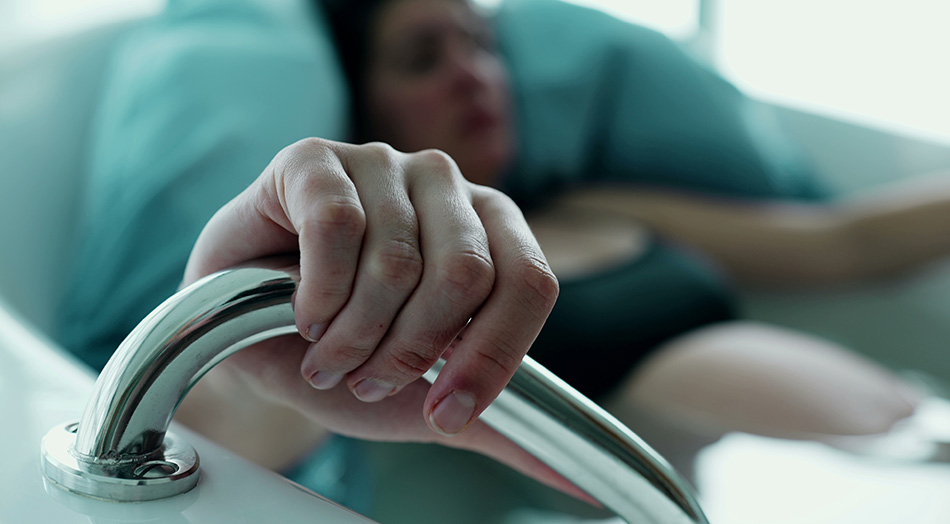
CARING FOR YOUR BLADDER
Your midwife will encourage you to pass urine regularly, at least every 2 to 4 hours, preferably by leaving the pool and walking to the toilet.
They may also ask you to measure the amount of urine you pass during your visits to the toilet. This will allow your midwife to assess your bladder function. For this reason, it is also important to let your midwife know if you pass urine in the birthing pool. Urine is sterile and will be diluted by the pool water so it is not harmful to your baby, but walking to the toilet will allow you to change your position and benefit from the effects of gravity while walking. It will also give your midwife an opportunity to refresh the water in the pool.
WATER DEPTH
The depth of the water in the pool is important because it creates the buoyancy effect which supports your weight and allows you to remain upright and change position more easily. The pool will be filled according to your height and the surface of the water should be level with your breasts when you are in a sitting position.
The pool at FV Hospital has a surface similar to that of a bath. You may therefore wish to use foam kneeling pads or floatation aids to enable you to remain mobile and facilitate your comfort, especially if you adopt a kneeling position. If you wish to do so, please make sure you bring your own selection. Floats cannot be provided due to the difficulties associated with cleaning them.
ADDITIONAL PAIN RELIEF
If you have used a Transcutaneous Electrical Nerve Stimulation (TENS) machine during early labour, you will need to take this off before you get into the pool.
Aromatherapy oils should not be added directly to the water. If aromatherapy oils have been used for massage during early labour and are still visible on your skin, your midwife will encourage you to have a shower while the pool fills.
YOUR BIRTH PARTNER
If you would like your birth partner to get into the pool to support you, this may be possible if your birth partner is wearing swimwear or a t-shirt and shorts.
FREQUENTLY ASKED QUESTIONS
What should I wear?
Most women choose to bathe naked in the pool, however, you may feel more comfortable wearing a bra, bikini top or t-shirt. You are advised to pack flip flops, extra towels and a bath robe so that you do not get cold, as you may get in and out of the pool several times during your labour.
When can I get into the pool?
It is best used when you are having strong, regular contractions and your labour is progressing well. Your midwife will advise you as to the best time.
When do I get out of the pool?
Whenever you feel you want to. If you feel the pool is not for you, or you request other pain relief, you may leave the pool. You may wish to get out of the pool and mobilise, eat/drink, reposition/rest to help your labour progress. Your midwife may ask you to leave the pool for different reasons – to use the bathroom, to refresh the water or if you have been in the pool for a long time. A break may offer greater benefits once you return to the pool. Your midwife will also request you to leave the pool if she feels your labour has slowed down, or there are concerns about you or your baby’s wellbeing.
How will midwives care for me in the pool?
We aim to create a private, secure, calm, and relaxed environment. We will encourage you as necessary and disturb you as little as possible. We will listen to your baby’s heartbeat; check your temperature, pulse and blood pressure regularly.
If your midwife is in anyway concerned about you or your baby during labour, you will be asked to leave the pool.
How will my baby’s heart rate be monitored?
The midwife will use a hand-held battery-operated heart rate monitor which can be safely used while you are in the water. The midwife will listen every 15 minutes to assess the wellbeing of your baby. If it has been decided that continuous monitoring of your baby’s heart rate is required, in certain situation the midwife can use a wireless telemetry monitor which enables this to happen.
What else can I use for pain relief when I am in the pool?
Many women find listening to their favourite music, massage, aromatherapy, deep breathing and/or the use of hypnobirthing techniques greatly enhance their birthing experience. If this does not provide enough pain relief for you the midwife may advise you to leave the pool for other pain relief such as Pethidine or an epidural.
Can I eat or drink when using the Pool?
It is important that you keep hydrated; your birth partner can help to remind you to take regular fluids and a light diet to keep up
your stamina. Examples of drinks include; orange/apple juice or isotonic ‘sports’ drinks. Pack some snacks in your hospital bag such as cream crackers or plain biscuits.
What if the pool in hospital is already in use?
As you do not know exactly when your labour will start it would be impossible to book the pool in advance because there is only one pool at FV Hospital Delivery Suite. However, it can be helpful to have considered an alternative plan in case there is no pool available when you arrive. You may wish to use other strategies such as one of the showers to help you relax. Should a pool become free during your labour we will inform you as soon as possible and provided there are no complications with your labour we will do our best to accommodate your preference.
How can my birth partner help?
The role of the birth partner is to support the mother in labour, physically and mentally helping her to feel relaxed and cared for. They can help by assisting you to change position, offering drinks frequently and using a facecloth rinsed in cool water to keep you cool. They can get into the pool if they wish wearing suitable clothing. If you have decided that you would like to use the pool, you and your partner may wish to complete a birth plan. This will ensure that your needs are fully understood.
Can I still use the pool if my waters are broken?
Yes, but only if the baby has not had its bowels open (passed meconium) and all is well with the labour. If the baby does have its bowels open it may mean that it is not coping with the stress of labour and will require closer monitoring out of the pool. Also, if your waters have been broken for more than 24 hours, we recommend that you do not use the pool.
Is there any risk of infection?
Evidence shows that the risk of getting an infection by using water for pain relief is minimal.
When labour has started
Telephone the FV Hospital’s Delivery Suite on 028 5411 3450 to let us know that you are coming in and that you would like to use the pool if it is available. When you arrive the midwife that will care for you will ask you some questions and look at your notes. She will examine your tummy to feel the position of your baby, and she may do an internal examination to help you decide when to get into the pool.
If your pregnancy is straightforward and no problems have been identified when you arrive, then the pool can be used. The pool will take approximately 20-30 minutes to fill. When it is ready you may enter whenever you wish. You may like to try different positions to maintain your comfort and get in and out of the water as you desire.
